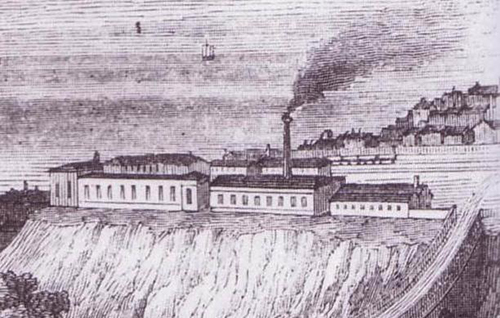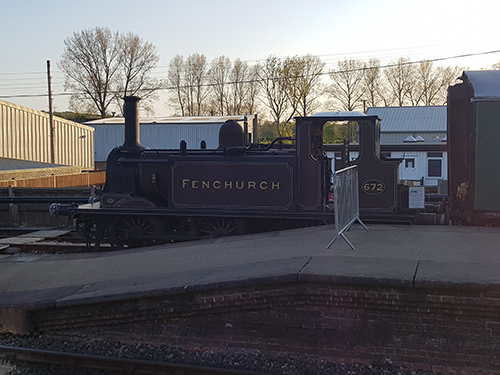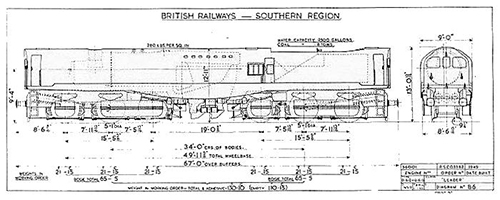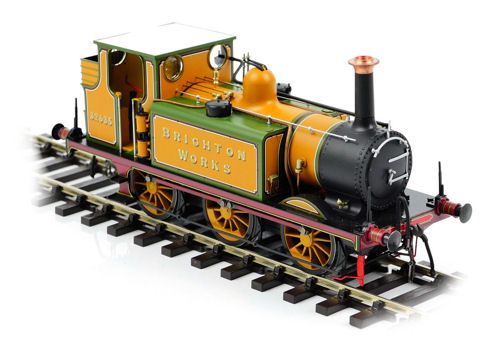

 STUART JORDAN tells us the history of the works in Brighton, and looks at some of the locomotives that were built there.
STUART JORDAN tells us the history of the works in Brighton, and looks at some of the locomotives that were built there.
The railway works at Brighton were one of the earliest in Britain to be opened, earlier than the more famous works in Doncaster and Swindon. During the time that Brighton Works was operational there was always a fight against the lack of space for expansion, and the ever-present threat of the works being moved to different locations. More than 1200 locomotives were built at Brighton between 1852 and 1957.
The first railway maintenance building in Brighton was an engine shed, built in 1840 by the London and Brighton Railway (L&BR). It was sited north-west of the station on the Shoreham-Brighton line. By the next year the facility had expanded to the east into a full motive power depot.

Brighton Works in 1846, as seen in a contemporary engraving.
In 1846 the L&BR merged with other local railways to form the London, Brighton, and South Coast Railway (LB&SCR). John Chester Craven became the superintendent, and he expanded the Brighton site by moving carriage construction there from New Cross. He cancelled plans for the motive power depot to be moved to Horley, and enlarged the works with facilities to build steam locomotives.
A new, larger motive power depot was built after ground on the western side of the London line was levelled, and the existing facilities were closed. Again, lack of space threatened Brighton Works. It was considered that locomotive repairs should be moved to New Cross, and William Stroudley looked into the previous plans of moving the facility to Horley. Marine engineering was moved to Newhaven, which freed up space at Brighton for an iron foundry to be built in 1873 - with a carriage painting works and a coppersmith following on in 1878 and 1881 respectively.
By the turn of the century, the boom in railway usage for both passengers and freight was having a negative effect on Brighton Works. The facilities simply couldn't keep up with the enlarged fleet of locomotives and the intensive level of work. Emergency measures were put in, with locomotives needing maintenance concentrated at stations around the network. An independent investigation in 1908 showed that 20% of the LB&SCR fleet was out of action, which rose to 30% by 1910.
Boiler changes and repairs were moved to the New Cross depot under District Locomotive Superintendent Lawson Billington. The blame for the problems fell squarely on Locomotive, Carriage, and Wagon Superintendent D.E. Marsh. After a short leave of absence, Marsh resigned in 1911 and Billington took over at Brighton - using the relatively new science of Time and Motion Studies to increase efficiency.
A new carriage and wagon works was opened at nearby Lancing in 1912, which further alleviated work from Brighton. Billington's eventual plan was to completely close Brighton Works and move the whole facility to Lancing, but this plan was not realised before 1914 and the start of the First World War. Brighton Works became a munitions factory, producing grenades for the British forces. After the war the backlog of repair work meant that locomotive construction did not begin again until 1920.
1923 saw the grouping of the railway into the Big Four, and the LB&SCR became part of Southern Railways, and Brighton Works started to decline. Most of the locomotive construction work was now being done at Eastleigh, and many staff were moved there - and also to the works at Ashford. The electrification of the Brighton mainline saw the former paint shed being converted into an Electrical Multiple Unit maintenance facility. The steam motive power depot reduced in size.
During the Second World War the locomotive construction facility was re-opened to accommodate the higher demand for locos during the war, and to spread production around to prevent an effective air raid crippling production. Engines were built at Brighton for companies around the country, including the War Department, and munitions production returned to the site. Minor damage was caused to the Works in an air raid in May 1943.
The railways were nationalised in 1948, and several of the new BR Standard Classes were designed and built at the locomotive factory, but the writing was on the wall for Brighton Works. Locomotive building stopped in 1957, and locomotive repairs in 1958. The motive power depot remained open until 1961, but the whole site had been demolished by 1969 after 129 years of railway activity. The workshops were used to build Isetta bubble cars for a short time, and the yard was used for stabling locomotives - with the land being used as a car park and temporary retail premises until relatively recently when it was developed into the New England Quarter, with just road names like Stroudley Road and Billington Way to hint at the history of the area.

The A1 Class Terrier "Fenchurch", in preservation at the Bluebell Railway.
The LB&SCR built two locomotives at Brighton that won prizes at two different Paris Exhibitions - the most famous being the A1 'Terrier' Class which was awarded a gold medal in 1870, and the B1 "Gladstone" Class which won the same prize in 1889. The Terrier worked the railways well into the BR period, with No. 32678 retiring in 1963 after 83 years of service - although the longest working Terrier was 32636 (Fenchurch), which worked from 1872 until 1962, an amazing 92 years. Both are amongst ten preserved Terriers that survive to this day.
During the Second World War, half of the forty Q1 Class locomotives were built by Southern at Brighton. This controversial but austere design lead to nicknames like "Coffee Pots" and "Ugly Ducklings".
After the war the majority of the West Country and Battle of Britain Class locomotives were built at Brighton, another austerity design that could be constructed easily and cheaply in the post-war economy. As the name suggests, the locomotives were named after West Country resorts or subjects relating to the Battle of Britain.

BR Leader Class works diagram.
More West Country Class locomotives were built under British Railways, but work on them ceased as production was switched to the bizarre experimental Leader Class. This articulated 0-6-0+0-6-0 design looked like a diesel locomotive, but was actually a steam engine. It was designed by Bullied to show the potential for steam power that still lay untapped, in the face of increased electrification and dieselisation. The Leader is a potential subject for an article in itself, so I won't go into too much detail here! The project was cancelled in the early 1950s after spiralling development costs and poor results. The last locomotives that were built at Brighton were Standard Class 4s, which were also designed there.

The Terrier Class A1X locomotive "Brighton Works" was first known as Morden, and carried the LB&SCR number 35. This locomotive was the first Terrier A1 to enter service in June 1878. The running number was changed several times; first to 635, and then onto 2635 once it became part of the Southern Railway stock in 1922, when it was also upgraded to A1X specification. After the war it was briefly given the numbering 377S and was transferred to departmental duties at Brighton.
It was at this time that it was repainted in Stroudley Improved Engine Green and given the name Brighton Works, with BR(SR) giving the locomotive final numbering of 32635. Brighton Works stayed at Brighton until 1959 when BR decided to return it to general use where it could be seen performing stock movements and shunting at various locations, but never straying too far from the Brighton area.
Towards the end of its life, it was fittingly put into service pulling steam specials around the south eastern region of the BR(SR) network. Brighton Works was retired in March 1963 but sadly did not make it into preservation, and was cut up at Eastleigh the same year.
This limited run model, which is part of the Gaugemaster Collection, is sure to be a popular locomotive not only with 7mm modellers, but also with collectors and fans of the Southern Railway.